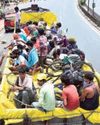The Maharshtra government’s Mumbai-Nagpur expressway is on course despite large tracts of irrigated land being lost to the project.

IN Maharashtra, a State whose economy is effectively in the red, Chief Minister Devendra Fadnavis has put all his might behind fulfilling his dream of building an eight-lane Mumbai-Nagpur expressway that will traverse 10 districts, covering a distance of 710 kilometres. This gigantic project is estimated to cost Rs.46,000 crore. But there is an even higher price that the State will have to pay for the project: 20,820 hectares of land.
The grandly named Maharashtra Samruddhi Mahamarg, or prosperity corridor, is not just about a highway that cuts the travel time by half between the two capitals of the State (traditionally, Nagpur hosts the winter session of the State legislature) but more about developing the region lying between them. This euphemism for land grab for industrial development is all too clear in this case. Of the 20,820 ha, a mere 8,520 ha will be needed for the expressway; the remaining 12,000 ha is meant for developing 24 townships. These townships, or development nodes, will house industries that range from agro-processing to information technology.
The expressway will run through 354 villages spread across 30 taluks. Close to 80 per cent of the land, that is, 17,499 ha, that is to be acquired for the project is agricultural land, 399 ha forest land and 2,922 ha unused land.
هذه القصة مأخوذة من طبعة August 18, 2017 من FRONTLINE.
ابدأ النسخة التجريبية المجانية من Magzter GOLD لمدة 7 أيام للوصول إلى آلاف القصص المتميزة المنسقة وأكثر من 9,000 مجلة وصحيفة.
بالفعل مشترك ? تسجيل الدخول
هذه القصة مأخوذة من طبعة August 18, 2017 من FRONTLINE.
ابدأ النسخة التجريبية المجانية من Magzter GOLD لمدة 7 أيام للوصول إلى آلاف القصص المتميزة المنسقة وأكثر من 9,000 مجلة وصحيفة.
بالفعل مشترك? تسجيل الدخول

How Not To Handle An Epidemic
The lockdowns were meant to buy time to put in place appropriate health measures and contain the coronavirus’ spread, but they have failed to achieve the objective and heaped immense misery on the marginalised sections of society. India is still in the exponential phase of the COVID-19 infection and community transmission is a reality that the government refuses to accept.

Tragedy on foot
As the COVID-19-induced lockdown cuts the ground beneath their feet in Tamil Nadu, thousands of migrant workers are trudging along the highway to the relative safety of their upcountry homes.

Sarpanchs as game changers
Odisha manages to keep COVID-19 well under control because of the strong participation of panchayati raj institutions and the community at the grass-roots level under the leadership of Chief Minister Naveen Patnaik.

Scapegoating China
As the COVID-19 death rate spikes and the economy tanks in the United States, Donald Trump and his advisers target China and the World Health Organisation with an eye to winning the forthcoming presidential election.

New worries
Kerala’s measured approach to the pandemic and lockdown has yielded results. But it still has to grapple with their huge economic impact on its economy, which it feels the Centre’s special financial relief package does little to alleviate.
No love lost for labour
Taking advantage of the lockdown and the inability of workers to organise protests, many State governments introduce sweeping changes to labour laws to the detriment of workers on the pretext of reviving production and boosting the economy.

Capital's Malthusian moment
In a world that needs substantial reorienting of production and distribution, Indian capital is resorting to a militant form of moribund neoliberalism to overcome its current crisis. In this pursuit of profit, it is ready and willing to throw into mortal peril millions whom it adjudicates as not worth their means—an admixture of social Darwinism born of capital’s avarice and brutalism spawned by Hindutva. .

Understanding migration
When governments and their plans are found to be blatantly wanting in addressing reverse migration, exercises such as the Ekta Parishad’s survey of migrant workers throughout India can be useful to work out creative long-lasting solutions.

Waiting for Jabalpur moment
The Supreme Court’s role in ensuring executive accountability during the ongoing lockdown leaves much to be desired. Standing in shining contrast is the record of some High Courts.

An empty package
The Modi regime, which has been unable to control the COVID-19 infection, restore economic activity and provide relief to millions exposed to starvation, trains its sights on Indian democracy, making use of the panic generated by fear and a lockdown that forecloses paths of resistance.